Abstract
The respiratory responses to hypercapnia alone and to hypercapnia and flow-resistive loading during inspiration were studied in normal individuals and in eucapnic and hypercapnic patients with chronic airways obstruction. Responses were assessed in terms of minute ventilation and occlusion pressure (mouth pressure during airway occlusion 100 ms after the onset of inspiration). Ventilatory responses to CO2 (deltaV/deltaPCO2) were distinctly subnormal in both groups of patients with airways obstruction. The two groups of patients, however, showed different occlusion pressure responses to CO2 (deltaP100/deltaPCO2): deltaP100/deltaPCO2 was normal in the eucapnic patients but subnormal in the hypercapnic patients. Flow-resistive loading during inspiration reduced deltaV/deltaPCO2 both in normal subjects and in patients with airways obstruction. The occlusion pressure response to CO2 increased in normal subjects during flow-resistive loading but remained unchanged in both groups of patients with chronic airways obstruction. These results indicate that while chemosensitivity as determined by deltaP100/deltaPCO2 is impaired only in hypercapnic patients with chronic airways obstruction, an acute increase in flow resistance elicits a subnormal increase in respiratory efferent activity in both eucapnic and hypercapnic patients.
Full text
PDF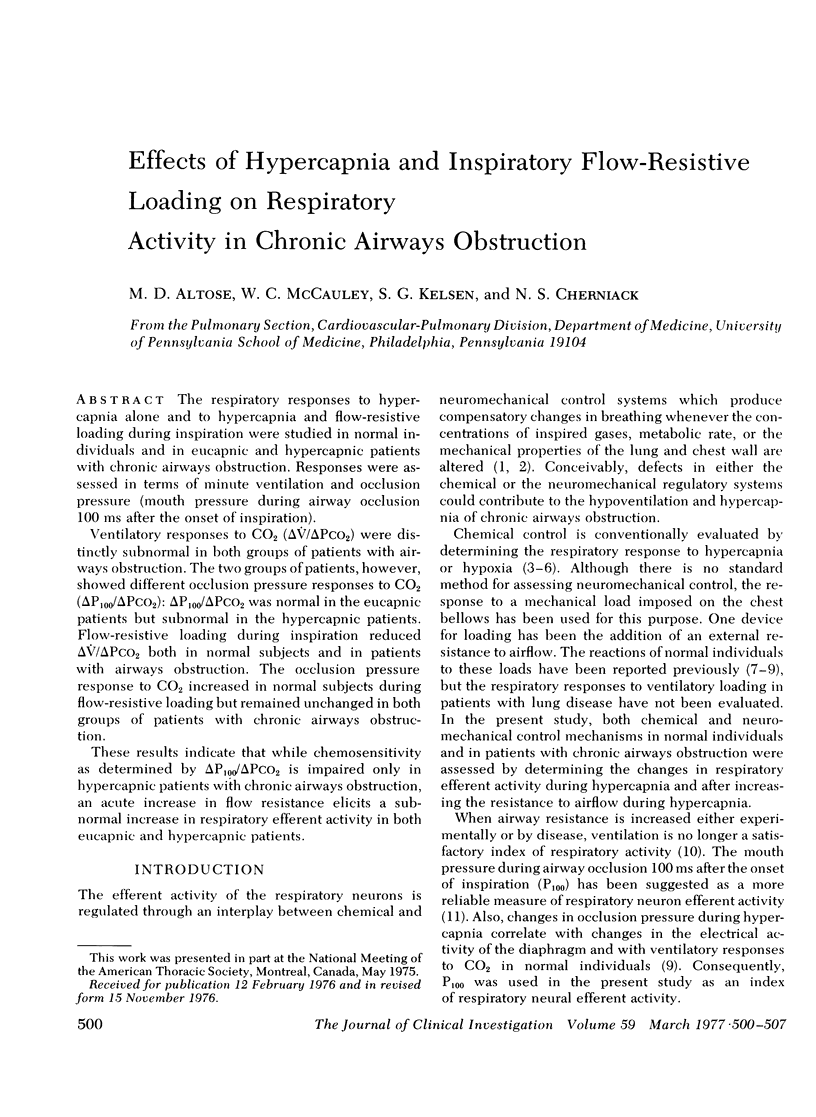
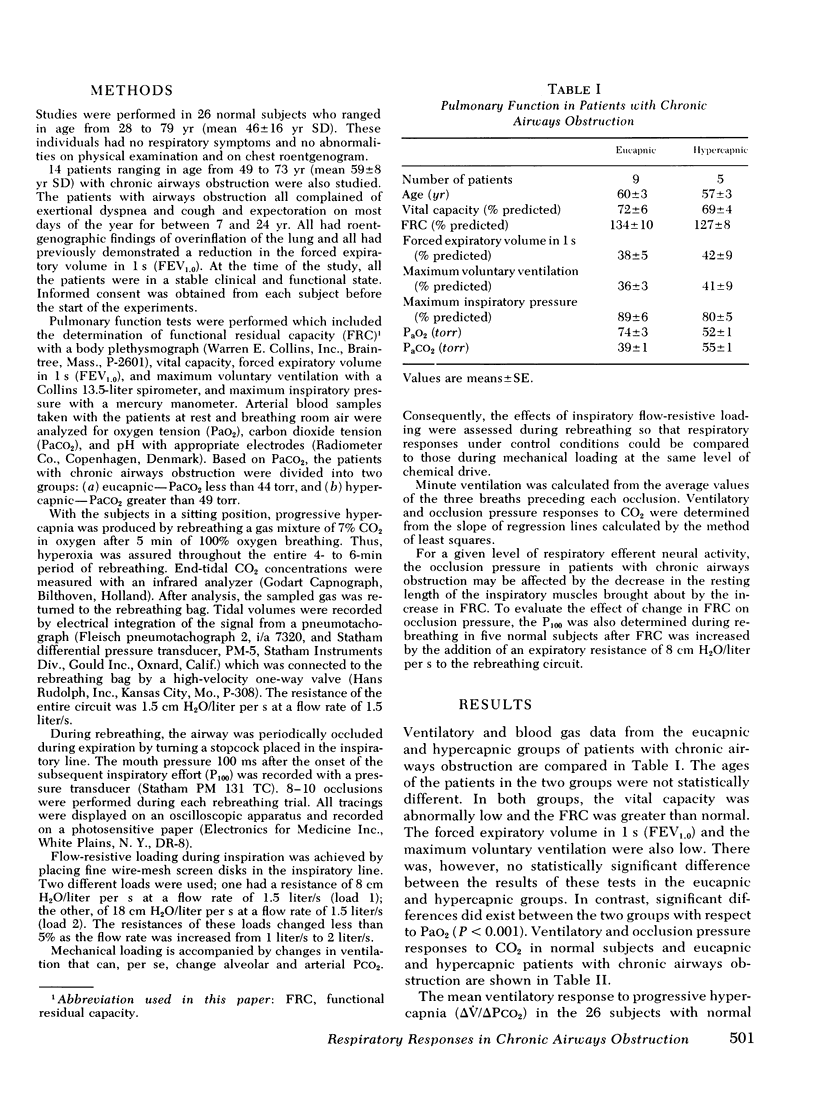
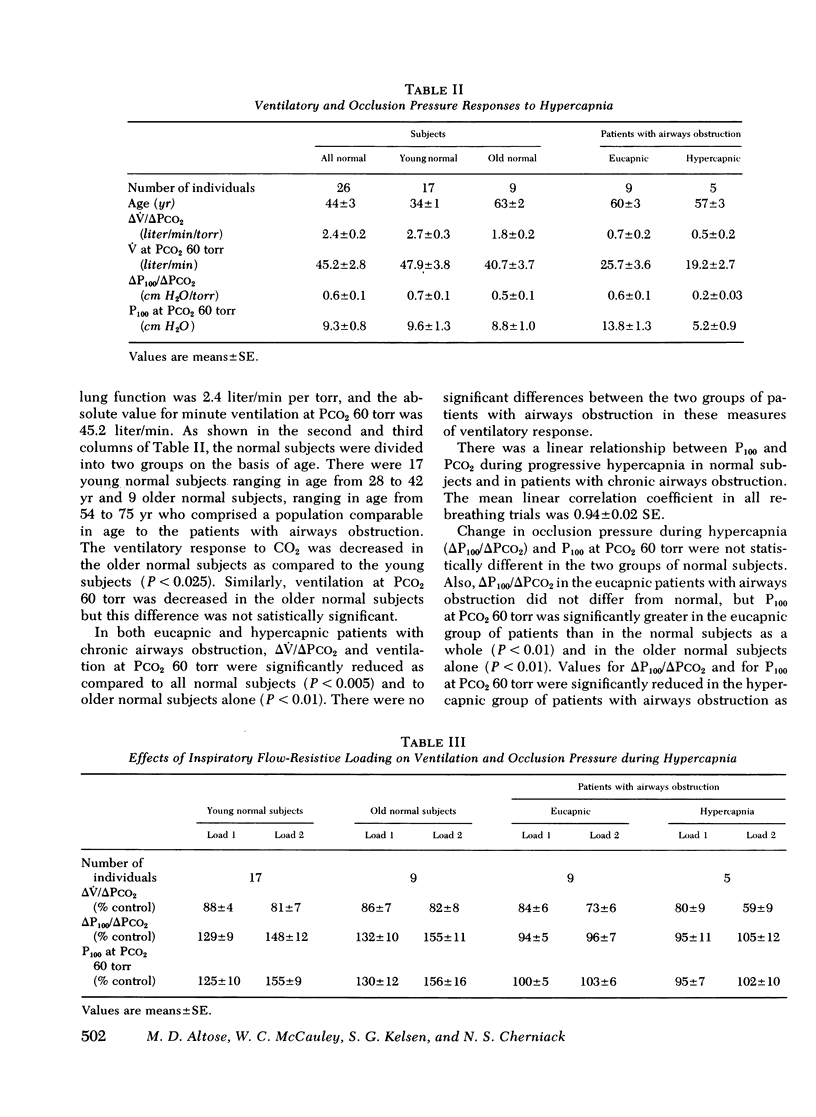
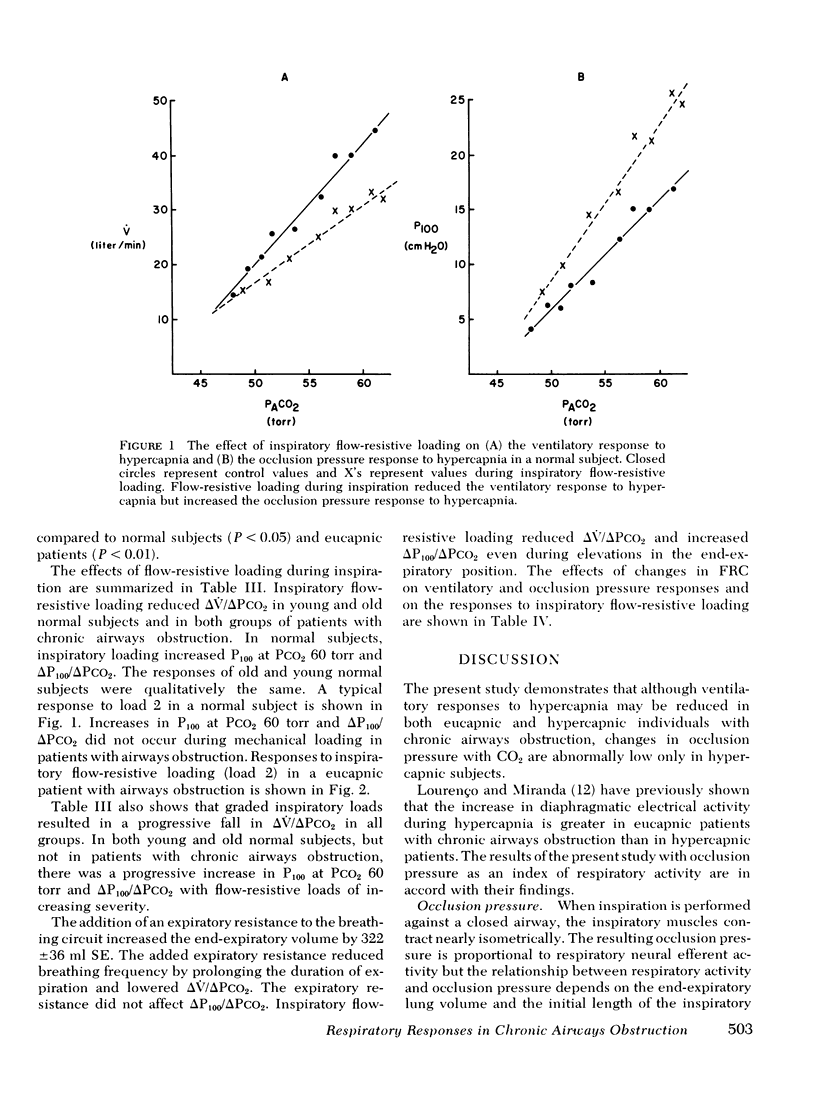
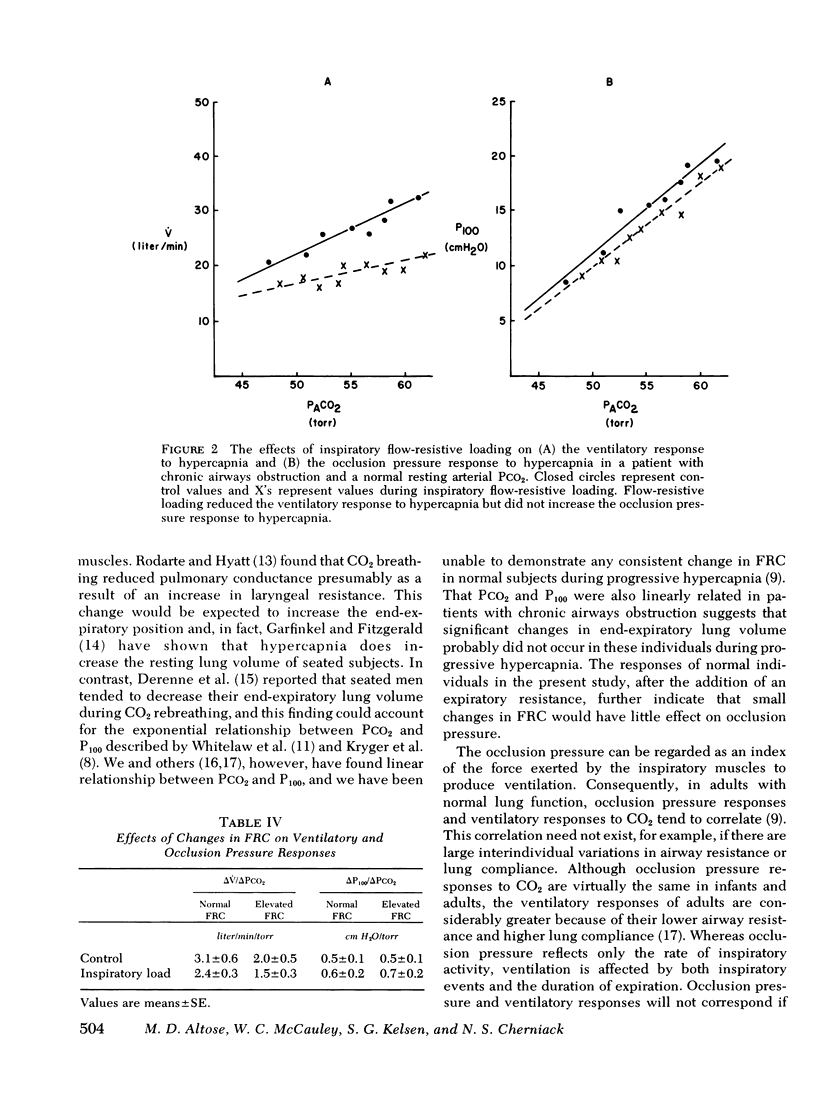
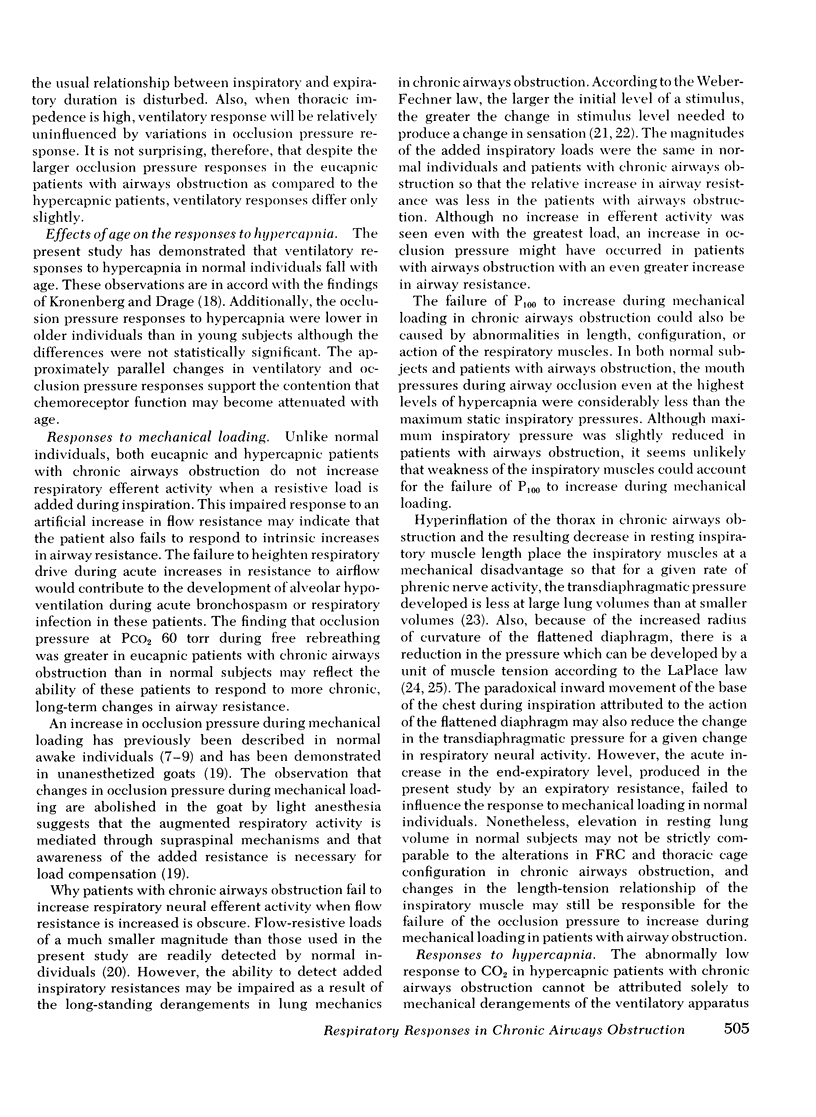
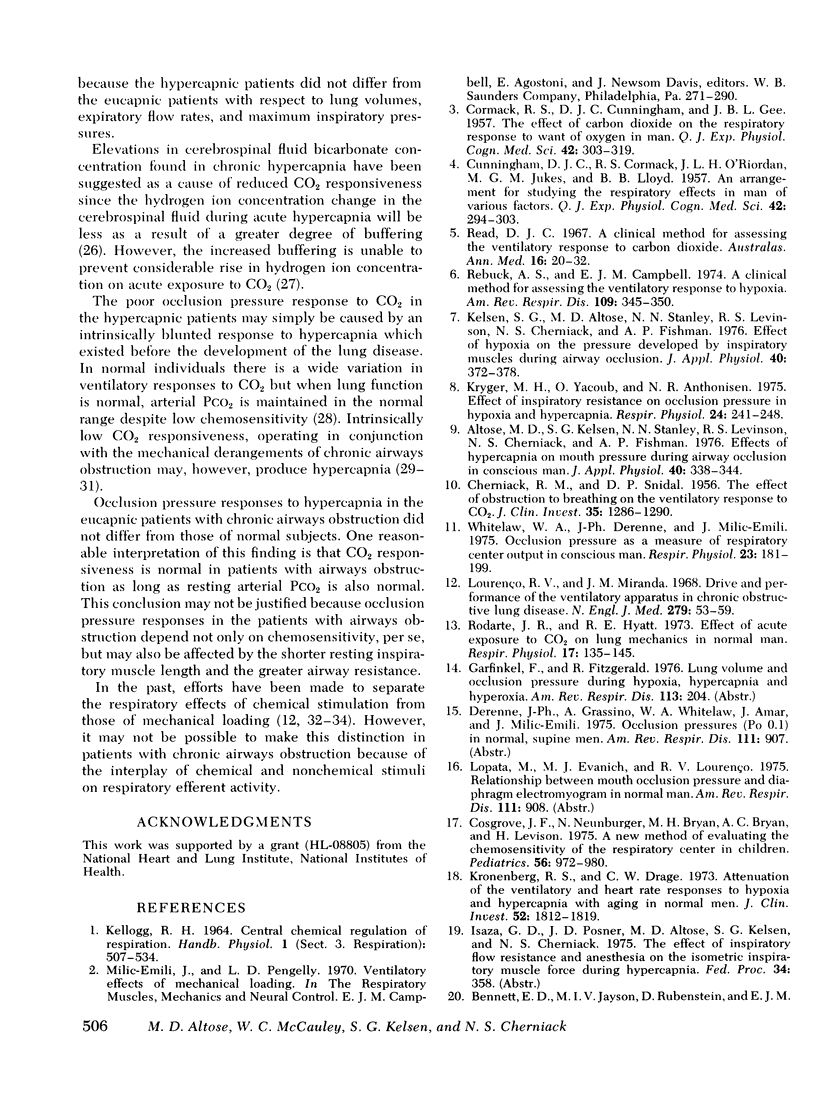
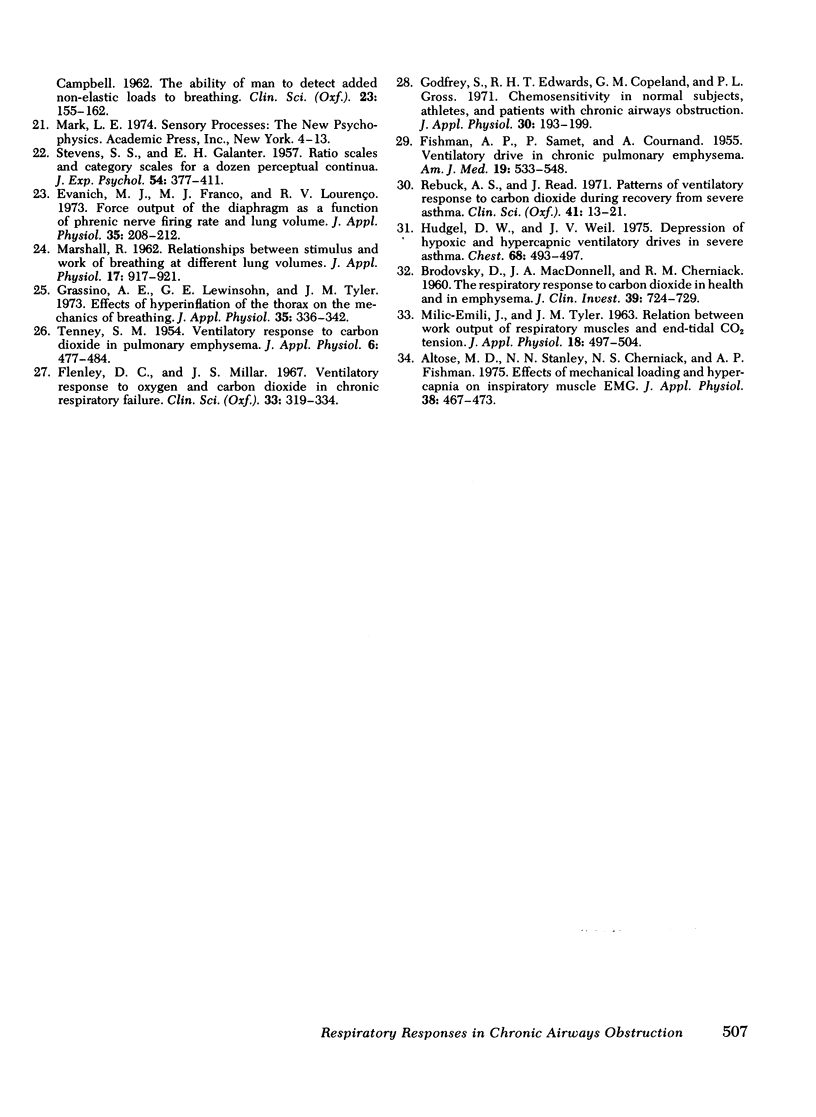
Selected References
These references are in PubMed. This may not be the complete list of references from this article.
- Altose M. D., Kelsen S. G., Stanley N. N., Levinson R. S., Cherniack N. S., Fishman A. P. Effects of hypercapnia on mouth pressure during airway occlusion in conscious man. J Appl Physiol. 1976 Mar;40(3):338–344. doi: 10.1152/jappl.1976.40.3.338. [DOI] [PubMed] [Google Scholar]
- Altose M. D., Stanley N. N., Cherniack N. S., Fishman A. P. Effects of mechanical loading and hypercapnia on inspiratory muscle EMG. J Appl Physiol. 1975 Mar;38(3):467–473. doi: 10.1152/jappl.1975.38.3.467. [DOI] [PubMed] [Google Scholar]
- BENNETT E. D., JAYSON M. I., RUBENSTEIND, CAMPBELL E. J. The ability of man to detect added non-elastic loads to breathing. Clin Sci. 1962 Aug;23:155–162. [PubMed] [Google Scholar]
- BRODOVSKY D., MACDONELL J. A., CHERNIACK R. M. The respiratory response to carbon dioxide in health and in emphysema. J Clin Invest. 1960 May;39:724–729. doi: 10.1172/JCI104089. [DOI] [PMC free article] [PubMed] [Google Scholar]
- CHERNIACK R. M., SNIDAL D. P. The effect of obstruction to breathing on the ventilatory response to CO2. J Clin Invest. 1956 Nov;35(11):1286–1290. doi: 10.1172/JCI103383. [DOI] [PMC free article] [PubMed] [Google Scholar]
- CORMACK R. S., CUNNINGHAM D. J., GEE J. B. The effect of carbon dioxide on the respiratory response to want of oxygen in man. Q J Exp Physiol Cogn Med Sci. 1957 Jul;42(3):303–319. doi: 10.1113/expphysiol.1957.sp001266. [DOI] [PubMed] [Google Scholar]
- CUNNINGHAM D. J., CORMACK R. S., O'RIORDAN J. L., JUKES M. G., LLOYD B. B. An arrangement for studying the respiratory effects in man of various factors. Q J Exp Physiol Cogn Med Sci. 1957 Jul;42(3):294–303. doi: 10.1113/expphysiol.1957.sp001265. [DOI] [PubMed] [Google Scholar]
- Cosgrove J. F., Neunburger N., Bryan M. H., Bryan A. C., Levison H. A new method of evaluating the chemosensitivity of the respiratory center in children. Pediatrics. 1975 Dec;56(6):973–980. [PubMed] [Google Scholar]
- Evanich M. J., Franco M. J., Lourenço R. V. Force output of the diaphragm as a function of phrenic nerve firing rate and lung volume. J Appl Physiol. 1973 Aug;35(2):208–212. doi: 10.1152/jappl.1973.35.2.208. [DOI] [PubMed] [Google Scholar]
- FISHMAN A. P., SAMET P., COURNAND A. Ventilatory drive in chronic pulmonary emphysema. Am J Med. 1955 Oct;19(4):533–548. doi: 10.1016/0002-9343(55)90345-4. [DOI] [PubMed] [Google Scholar]
- Flenley D. C., Millar J. S. Ventilatory response to oxygen and carbon dioxide in chronic respiratory failure. Clin Sci. 1967 Oct;33(2):319–334. [PubMed] [Google Scholar]
- Grassino A. E., Lewinsohn G. E., Tyler J. M. Effects of hyperinflation of the thorax on the mechanics of breathing. J Appl Physiol. 1973 Sep;35(3):336–342. doi: 10.1152/jappl.1973.35.3.336. [DOI] [PubMed] [Google Scholar]
- Hudgel D. W., Weil J. V. Depression of hypoxic and hypercapnic ventilatory drives in severe asthma. Chest. 1975 Oct;68(4):493–497. doi: 10.1378/chest.68.4.493. [DOI] [PubMed] [Google Scholar]
- Kelsen S. G., Altose M. D., Stanley N. N., Levinson R. S., Cherniack N. S., Fishman A. P. Effect of hypoxia on the pressure developed by inspiratory muscles during airway occlusion. J Appl Physiol. 1976 Mar;40(3):372–378. doi: 10.1152/jappl.1976.40.3.372. [DOI] [PubMed] [Google Scholar]
- Kronenberg R. S., Drage C. W. Attenuation of the ventilatory and heart rate responses to hypoxia and hypercapnia with aging in normal men. J Clin Invest. 1973 Aug;52(8):1812–1819. doi: 10.1172/JCI107363. [DOI] [PMC free article] [PubMed] [Google Scholar]
- Kryger M. H., Yacoub O., Anthonisen N. R. Effect of inspiratory resistance of occlusion pressure in hypoxia and hypercapnia. Respir Physiol. 1975 Sep;24(3):241–248. doi: 10.1016/0034-5687(75)90016-x. [DOI] [PubMed] [Google Scholar]
- Lourenço R. V., Miranda J. M. Drive and performance of the ventilatory apparatus in chronic obstructive lung disease. N Engl J Med. 1968 Jul 11;279(2):53–59. doi: 10.1056/NEJM196807112790201. [DOI] [PubMed] [Google Scholar]
- Read D. J. A clinical method for assessing the ventilatory response to carbon dioxide. Australas Ann Med. 1967 Feb;16(1):20–32. doi: 10.1111/imj.1967.16.1.20. [DOI] [PubMed] [Google Scholar]
- Rebuck A. S., Campbell E. J. A clinical method for assessing the ventilatory response to hypoxia. Am Rev Respir Dis. 1974 Mar;109(3):345–350. doi: 10.1164/arrd.1974.109.3.345. [DOI] [PubMed] [Google Scholar]
- Rebuck A. S., Read J. Patterns of ventilatory response to carbon dioxide during recovery from severe asthma. Clin Sci. 1971 Jul;41(1):13–21. doi: 10.1042/cs0410013. [DOI] [PubMed] [Google Scholar]
- Rodarte J. R., Hyatt R. E. Effect of acute exposure to CO 2 on lung mechanics in normal man. Respir Physiol. 1973 Mar;17(2):135–145. doi: 10.1016/0034-5687(73)90057-1. [DOI] [PubMed] [Google Scholar]
- STEVENS S. S., GALANTER E. H. Ratio scales and category scales for a dozen perceptual continua. J Exp Psychol. 1957 Dec;54(6):377–411. doi: 10.1037/h0043680. [DOI] [PubMed] [Google Scholar]
- TENNEY S. M. Ventilatory response to carbon dioxide in pulmonary emphysema. J Appl Physiol. 1954 Feb;6(8):477–484. doi: 10.1152/jappl.1954.6.8.477. [DOI] [PubMed] [Google Scholar]
- Whitelaw W. A., Derenne J. P., Milic-Emili J. Occlusion pressure as a measure of respiratory center output in conscious man. Respir Physiol. 1975 Mar;23(2):181–199. doi: 10.1016/0034-5687(75)90059-6. [DOI] [PubMed] [Google Scholar]


